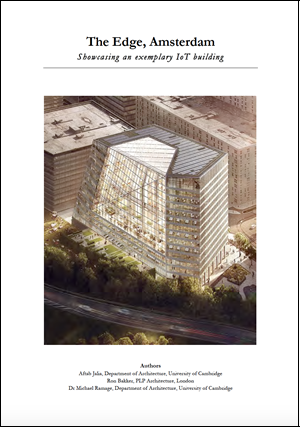This project developed The Edge as a case study for CDBB, not only for the sake of information on the building alone, but also to use it as a template to build the “standard case study template.” When we consider other buildings, we can understand them through comparable qualitative and quantitative metrics developed from the most complete example in existence today. Developing the future of the digital built environment will require intensive study of a number of exemplars.
Buildings pose complex design problems that require the harmonious synthesis of aesthetics, function and digital capabilities. In its resolute promotion of BIM and progression from Level 2 to Level 3 over the coming years, the Government of the United Kingdom is promoting an inclusive working process that provides a single platform to key stakeholders involved in the design and construction of buildings to speak the same language. Communication lies at the heart of BIM with proven advant ages in process-flows leading to work efficiencies and cost savings.
The Edge is an office building in Amsterdam that showcases the benefits of BIM. Completed in 2015, The Edge was built with the Internet of Things (IoT) as its foundational principle. Its design and construction phases did not use BIM in the prescribed sense but its implementation of smart technologies enables The Edge to achieve many of BIM’s benefits and perhaps even serve as an exemplar for a few. Some of these are: automated energy performance visualisation, building usage monitoring, potential for predictive facilities maintenance and post-processing for energy analysis.
Since its completion, The Edge has been internationally admired as the smartest and most connected office building in the world and has also been called a computer with a roof. At the time of its completion, it was BREEAM’s highest rated building. The Edge’s nearly 28,000 sensors continuously feed data generated by users into a ‘data lake’ that is available to service personnel for analysis and modelling. Furthermore, a formidable mix of sustainable architectural design solutions supported by a digital backbone make The Edge a forerunner of digital built environments.

The Edge seen from the motorway. The atrium is the social heart of The Edge with its café, tiered workspaces lit by diffused north light. Photos: Ronald Tilleman
However, the success of The Edge goes beyond its use of cutting-edge technologies and instead lies in effective communication between key drivers who championed diverse and original ideas. This report identifies those key drivers, elucidates the synergy of their communication and presents lessons and limitations of this pioneering building in the context of digital built Britain.
Researchers
Dr Aftab Jalia
Department of Architecture Centre for Natural Material Innovation
Dr Michael Ramage
Department of Architecture
Ron Bakker
PLP Archicture

